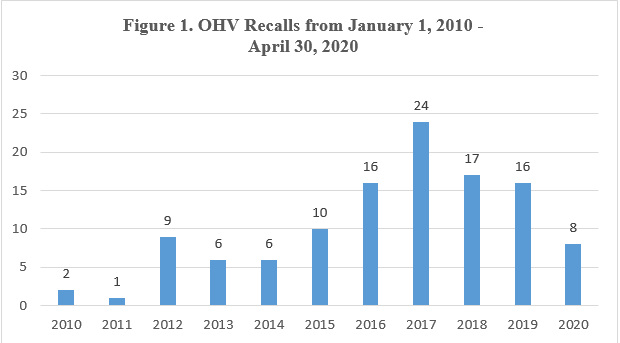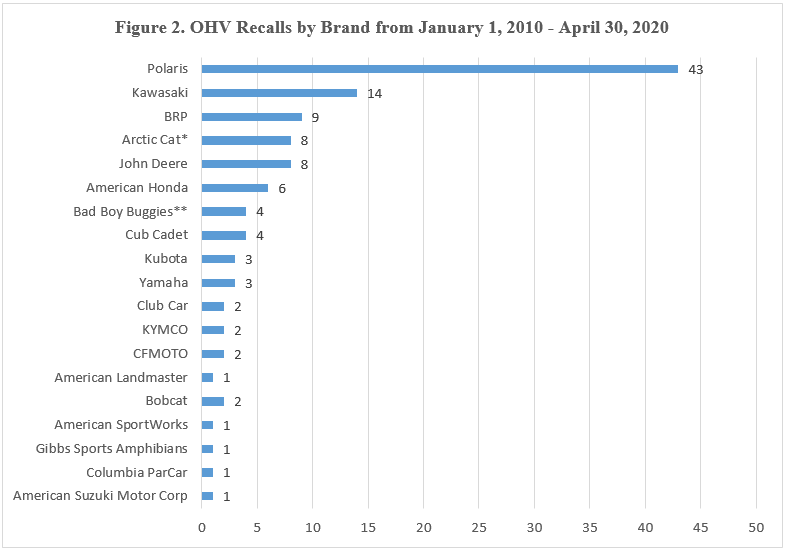A Consumer Federation of America (CFA) analysis of off highway vehicle (OHV) recalls found that over the past 10 years, there have been 115 OHV recalls, and the number of recalls has increased from two recalls in 2010 to 17 recalls in 2018, and 16 in 2019. In 2020 thus far, there have been eight OHV recalls. OHVs include all-terrain vehicles (ATVs), recreational off-highway vehicles (ROVs), and utility task vehicles (UTVs). CFA’s analysis of U.S. Consumer Product Safety Commission (CPSC) OHV recall reports since 2010 found that the highest number of recalls occurred during the past three years, from January 1, 2016 through January 1, 2019.
In addition, CFA analysis of CPSC OHV recall reports from January 1, 2010 through April 30, 2020 found that 19 brands[1] were involved in the recalls, and the brand with the most recalls (over triple that of the brand with the second most recalls) was Polaris.[2] CPSC reports identified at least 70 injuries and two deaths linked to OHVs that were subsequently recalled. Also, over one and a half million[3] OHVs were estimated to be sold and subsequently recalled.
Recall Volume by Brand and Year
From January 1, 2010 through April 30, 2020, a total of 115 recall notices were identified. Nineteen brands were involved in the notices, and the brand that had the most recall notices during the period was Polaris. Figure 1, below, shows the number of OHV recalls during the report period. In 2017, there were a total of 24 recalls—the highest number of recalls in a single year during the period analyzed. In 2019, there were 16 recalls. In 2018, there were 17 recalls and in 2016, there were 16 recalls. In 2011, there was one recall, but the following year the number of recalls increased to nine, a nine-fold increase, which was the highest increase, between years, for the time period analyzed by CFA.
The OHV recalls involve 19 different brands. Figure 2, below, shows that Polaris had the most recalls, 43, while Kawasaki had the second highest number of recalls, 14. BRP/Can-Am had the third highest number of recalls, nine.
*Arctic Cat issued three recall notices under the name Arctic Cat on March 2014, July 2015, and August 2016. In October 2017 and November 2017, Arctic Cat issued a recall but under the name Textron. According to Textron’s website, Textron announced it purchased Arctic Cat in March 2017. For the purposes of this analysis, the Textron recall for Arctic Cat was included under the name Arctic Cat.
**Different CPSC recall notices for Bad Boy Buggies differ on who is issuing the recall. On January 2017, Textron issued a recall for Bad Boy Buggies, and it was listed as the manufacturer of Bad Boy Buggies in the CPSC recall notice. On April 2014 and December 2011, Bad Boy Buggies issued two recalls for UTVs alongside E-Z-GO. E-Z-GO issued the two recalls for golf carts. Both Bad Boy Buggies and E-Z-GO are manufactured by Textron, according to the CPSC recall notices. For the purposes of this analysis, the recalls issued under Textron and E-Z-GO for Bad Boy Buggy products are included under the name Bad Boy Buggies.
In 2019, we included five actions as recalls but these actions are unilateral actions by the manufacturer, Polaris, that were deemed “Stop Sale/Stop Ride Notices.” One of these notices was issued in June 2019, two notices were issued in October of 2019, and two were issued in December of 2019. These “Stop Sale/Stop Ride Notices” did not involve the CPSC and the CPSC did not communicate these actions to the public. These “Stop Sale/ Stop Ride Notices involved 92,353 vehicles in total and were recalled for a number of reasons including: seat belts not functioning properly; fire hazards, including: incorrect fuel line routing, fuel rail fasteners being improperly torqued, damage to fuel lines in the event of a drive belt failure; and a clutch inlet duct not being removed prior to shipping. While Polaris did not include any information about injuries in these notices, Polaris did include that four incidents occurred where the drive belt failed and damage to the fuel line resulted, and five incidents occurred where the clutch inlet duct created a fire hazard.
Recalls Driven by Fire, Throttle, and Steering Hazards
There are numerous reasons why OHVs have been recalled, and CFA was able to identify some patterns. For example, looking at the entire period, the cause of the most recalls is fire hazards. Fire related hazards accounted for 52 recalls (45%). The second most common hazard indicated in the OHV recall notifications related to throttle issues which accounted for 15 of the 115 recalls or 13%. The third most common hazard identified as the cause of OHV recalls involved steering related issues which made up 13 recalls (11%). These top three hazards represent nearly three-quarters of hazards that led to recalls (69%).
Fire related hazards include issues such as fuel hoses leaking, exhaust pipes cracking, firewalls failing, melting of components, and other fuel related-issues. Issues related to the throttle include the throttle failing to return to idle or failing in some way. Examples of steering related issues include the steering shaft breaking and the electronic power steering unit malfunctioning.
Injuries and Deaths
Injuries and deaths were involved in nearly one quarter of all of the OHV recalls. Out of the 115 recalls analyzed, 24 recalls (21%) involved at least one injury. Tragically, the most serious involved two deaths. The most recent death occurred in January 2017 and involved the rollover of an OHV that was subsequently recalled because it did not have seatbelts, resulting in the death of a 14-year-old passenger. The second death occurred in April 2016 on an OHV that caught fire (the specific part of the vehicle that caught fire was not identified) and then rolled over, resulting in the death of a 15-year-old passenger.
There were 70 injuries included in the recall notices. The CPSC did not always identify the severity of the injuries, but of the 70 injuries included, there were at least two severe injuries. One individual suffered a serious leg injury after a rollover incident (the vehicle in this incident was part of the same recall as the January 2017 death above). And the second severe injury included a young child who suffered severe burns after an ROV caught fire (this recall noted that an additional five people suffered burn injuries but did not label them severe).
1,723,093 Vehicles Subsequently Recalled were Sold
For every recall issued, the CPSC estimates the number of impacted vehicles sold. For the 115 recalls analyzed, the CPSC estimates that 1,723,093 vehicles subsequently recalled were sold. The recalls that involved the largest number of OHVs were three Polaris recalls, one Kawasaki recall, and one American Honda recall. The Polaris RZR ROV recall impacted approximately 133,000 vehicles, in April 2016, and was due to the risk of the vehicle catching fire and involved the largest number of vehicles recalled during the period analyzed.
The second highest number of individual vehicles involved a Polaris RZR ROV recall, due to heat shield problems. This recall occurred in April 2018 and involved approximately 107,000 vehicles. The recall with the third highest number of vehicles involved an American Honda ROV recall and included 82,000 vehicles in June 2019 due to the throttle pedal sticking in the open position. Both of the two recalls with the fourth highest number of vehicles involved approximately 80,000 vehicles: one occurred in March 2020 and involved a Kawasaki UTV due to a crash hazard posed by the steering shaft crash, and the other occurred in April 2020 and involved a Polaris UTV that posed a fire hazard due to the clutch belt.
Investigation into Cause of Increasing Recalls Needed
OHVs are powerful vehicles that can pose safety risks to OHV drivers and passengers even during seemingly low risk conditions. But when drivers are unwittingly using defective OHVs, the safety risk increases even more. More defective vehicles being used means more potential injuries and deaths.
OHV companies must do everything necessary to ensure the safety of their products. While we applaud companies for taking responsibility and recalling their products, problems should be identified before the products enter the marketplace and pose risks to consumers. We urge companies to continue to voluntarily recall products with the CPSC and not unilaterally take actions that are not recalls. This analysis identified that more OHV recalls have been occurring more recently. These recalled OHVs have been involved in incidents resulting in at least two deaths and 70 injuries. The CPSC must investigate why the number of OHV recalls are increasing and take steps, along with OHV manufacturers, to prevent these tragedies and improve the safety of these vehicles.
[1] Brand, is used to denote the type of OHV being recalled. While the brand is sometimes synonymous with the manufacturer, it is sometimes the name of an OHV produced by a manufacturer of a different name. In some instances, it is not clear from the recall notice who the manufacturer is.
[2] A single CPSC recall notice can include a single model or multiple models, as well as a single model year or multiple model years, or any combination of these factors.
[3] There were five CPSC recall notices that included golf carts alongside OHVs. The CPSC recall notices did not separate the total units of the OHV products from the golf cart products. Therefore this total includes some units of golf carts.
See Appendix below for the full list of OHV recalls we have cataloged.



